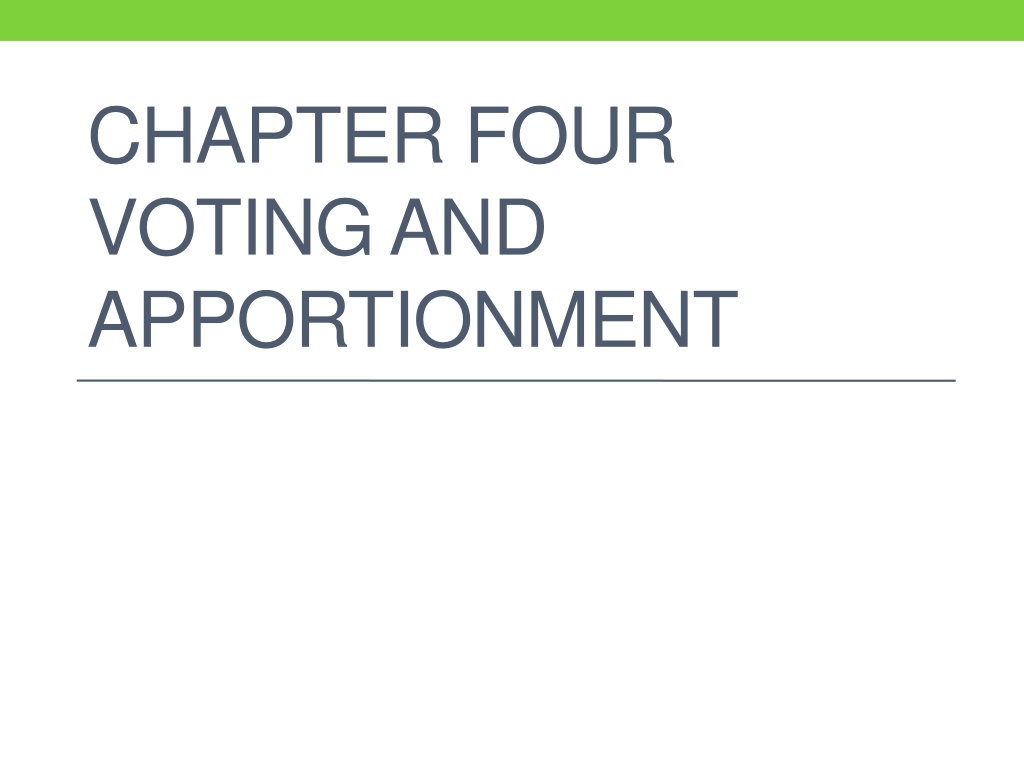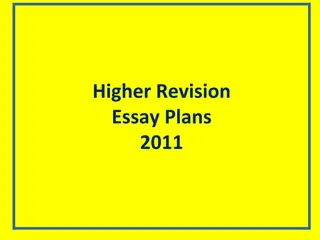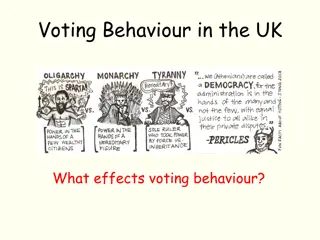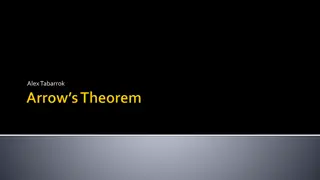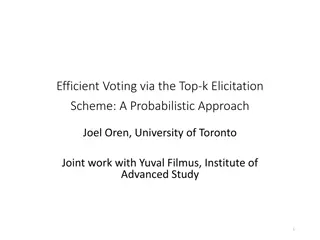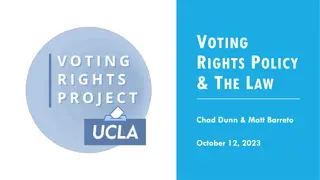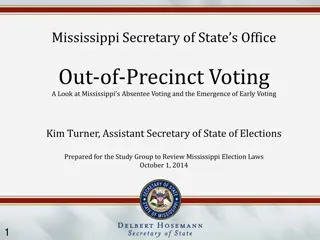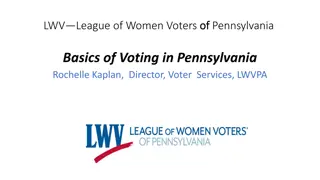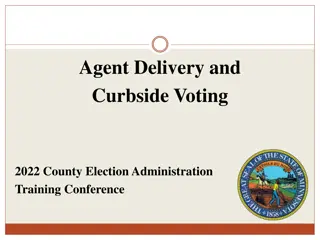Understanding Voting Methods: Majority, Plurality, and Borda Count
Explore different voting methods like majority rule, plurality rule, and Borda count with examples and explanations. Learn how candidates can win elections based on different voting systems and the significance of each method in decision-making processes.
Download Presentation

Please find below an Image/Link to download the presentation.
The content on the website is provided AS IS for your information and personal use only. It may not be sold, licensed, or shared on other websites without obtaining consent from the author. Download presentation by click this link. If you encounter any issues during the download, it is possible that the publisher has removed the file from their server.
E N D
Presentation Transcript
CHAPTER FOUR VOTING AND APPORTIONMENT
Introduction to Voting The Theory of how decisions can be made by groups is called social choice theory. If more than one person decides, it is called a vote. We will be interested in various wsys of voting . We will always assume that all boters have the same weight.
Majority Rules Each voter votes for one candidate. The candidate receiving more than 50% of the votes wins. Example 1. Adam, Bob, and Cecil are three candidates running for president of the Friends of Sociology Society. Suppose there are 500 members in the Friends of Sociology Society, how many votes does Cecil need to win if the voting method used is majority rule.
Example 1. Adam, Bob, and Cecil are three candidates running for president of the Friends of Sociology Society. Suppose there are 500 members in the Friends of Sociology Society, how many votes does Cecil need to win if the voting method used is majority rule. Solution: 500 50% = 250 According to the majority rule, Cecil need to get more than 250 votes to win the election. Therefore, Cecil need to get at least 251 votes to win.
Plurality Rules Each voter votes for one candidate. The candidate with the most votes wins. Example 2. Adam, Bob, and Cecil are three candidates running for president of the Friends of Sociology Society. If Adam has 27 votes and Bob has 32 votes, then how many votes does Cecil need to win if the voting method used is plurality?
Example 2. Adam, Bob, and Cecil are three candidates running for president of the Friends of Sociology Society. If Adam has 27 votes and Bob has 32 votes, then how many votes does Cecil need to win if the voting method used is plurality? Solution: According to the plurality rule, Cecil need to win more votes than either Adam or Bob. So Cecil need to receive at least 33 votes to win the election.
Borda Count Voters rank all candidates. For each voter, one point is assigned to the voter s lowest-ranked candidate, two points to the second lowest, and so on Points are summed. And the candidate with the most points win. This method was proposed by Jean-Charles de Borda, a French mathematician and inventor, shortly after French Revolution. It is used to elect the Heisman trophy winner in football.
Example 3 A club with ten members decided to elect the president using a Borda count. Three candidates, A, B and C, ran for the office. The club secretary tallied the votes in a table showing below. Who won the election? Member# 1 2 3 4 Ranking BCA CBA BAC BAC 5 BCA ACB 6 7 ABC 8 ACB 9 CBA 10 CBA Solution: Voter 1 s ranking of BCA gives A one point, C two points, and B three points. Voter 2 s ranking of CBA gives A one point, B two points, and C three points. If we repeat this for all voters and add up the points, We find that A got 18 points, B got 22 points, and C got 20 points. So B wins a Borda count.
Example 4 A reading group with ten members has decided to use a Borda count to determine which book to read next. Three candidates, A, B and C, are being considered. The group s secretary recorded the following ranking. Who won? Member# Ranking 1 BAC 2 CAB CAB 3 4 BAC 5 CBA ACB 6 7 ACB 8 ABC 9 CBA 10 CAB
Example 4 A reading group with ten members has decided to use a Borda count to determine which book to read next. Three candidates, A, B and C, are being considered. The group s secretary recorded the following ranking. Who won? Member# Ranking 1 BAC 2 CAB CAB 3 4 BAC 5 CBA ACB 6 7 ACB 8 ABC 9 CBA 10 CAB Solution: Voter 1 s ranking of BAC gives A two points, C one point, and B three points. Voter 2 s ranking of CAB gives A two points, B one points, and C three points. If we repeat this for all voters and add up the points, We find that A got 21 points, B got 17 points, and C got 22 points. So C wins a Borda count.
True Majority Rule Condorcet Candidate If there is candidate who is preferred to all others in head- to-head contests, that candidate is called the Condorcet Candidate. True Majority Rule The Condorcet Candidate wins. Example 5 The One Hundred Member Club has voted for its president. Four candidates, A, B, C and D ran for the office, with the following results. Who is the Condorcet Candidate to win the election? ABCD 2 BCAD 49 CDBA 48 DCBA 1 Ranking # of voters
True Majority Rule Example 5 The One Hundred Member Club has voted for its president. Four candidates, A, B, C and D ran for the office, with the following results. Who is the Condorcet Candidate to win the election? Ranking ABCD BCAD CDBA DCBA # of voters 2 49 48 1 Solution: A is preferred to B only by 2 votes, while B is preferred to A by 98 votes. So B wins when compared to A. Similarly, B is preferred to C only by 2+49=51 votes, while C is preferred to B by 48+1=49 votes, so B wins when compared to C. Finally, B is preferred to D only by 2+49=51 votes, while D is preferred to B by 49 votes. Therefore, B wins when compared head-to-head to any other candidate. So B is the Condorcet Candidate and as such won.
True Majority Rule Example 6 An election with three candidates gave the following results. Ranking ABC ACB BAC BCA CAB # of voters 15 21 9 17 12 (1) Was there a Condorcet Candidate? (2) If a Borda Count is used, who wins? Does this violate the Condorcet criterion?
True Majority Rule Example 6 An election with three candidates gave the following results. ABC ACB BAC BCA CAB Ranking # of voters 15 21 9 17 12 (1) Was there a Condorcet Candidate? (2) If a Borda Count is used, who wins? Does this violate the Condorcet criterion? Solution (1) A is preferred to B by 15+21+12=48 votes, while B is preferred to A by 9+17=26 votes. So A wins when compared to B. Similarly, A is preferred to C by 15+21+9=45 votes, while C is preferred to A by 17+12=29 votes, so A wins when compared to C. Therefore A is a Condorcet Candidate and wins the election.
True Majority Rule Example 6 An election with three candidates gave the following results. Ranking ABC ACB BAC BCA CAB # of voters 15 21 9 17 12 (1) Was there a Condorcet Candidate? (2) If a Borda Count is used, who wins? Does this violate the Condorcet criterion? Solution (2) 15 voters voted the rank of ABC gives A three point, B two points, and C one point, with the number of voters counted, Candidate A won 3 15 = 45 points; Candidate B won 2 15 = 30 points; Candidate C won 1 15 = 15 point
True Majority Rule Example 6 An election with three candidates gave the following results. ABC ACB BAC BCA CAB Ranking # of voters 15 21 9 17 12 (1) Was there a Condorcet Candidate? (2) If a Borda Count is used, who wins? Does this violate the Condorcet criterion? Solution (2) Continued 21 voters voted the rank of ACB gives A three point, C two points, and B one point, with the number of voters counted, Candidate A won 3 21 = 63 points; Candidate B won 1 21 = 21 points; Candidate C won 2 21 = 42 points; we repeat this and have the following calculation on total points all three candidates receive
True Majority Rule Example 6 An election with three candidates gave the following results. Ranking ABC ACB BAC BCA CAB # of voters 15 21 9 17 12 (1) Was there a Condorcet Candidate? (2) If a Borda Count is used, who wins? Does this violate the Condorcet criterion? Solution (2) continued Total points Candidate A won: 3 15 + 3 21 + 2 9 + 1 17 + 2 12 = 167; Total points Candidate B won: 2 15 + 1 21 + 3 9 + 3 17 + 1 12 = 141; Total points Candidate C won: 1 15 + 2 21 + 1 9 + 2 17 + 3 12 = 136; So candidate A won for Borda Count rule.
Summary For the same question, the winner of Borda Countis Candidate A, which violates the Condorcet candidate B
